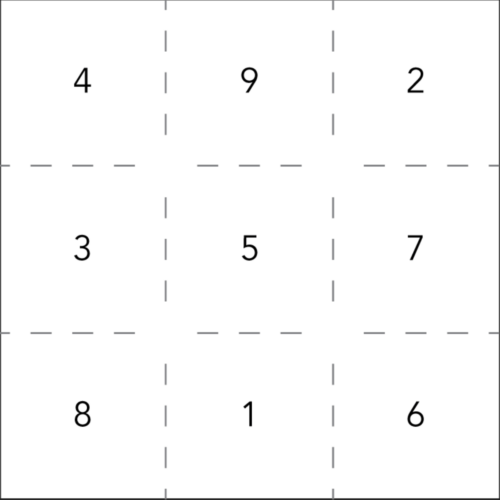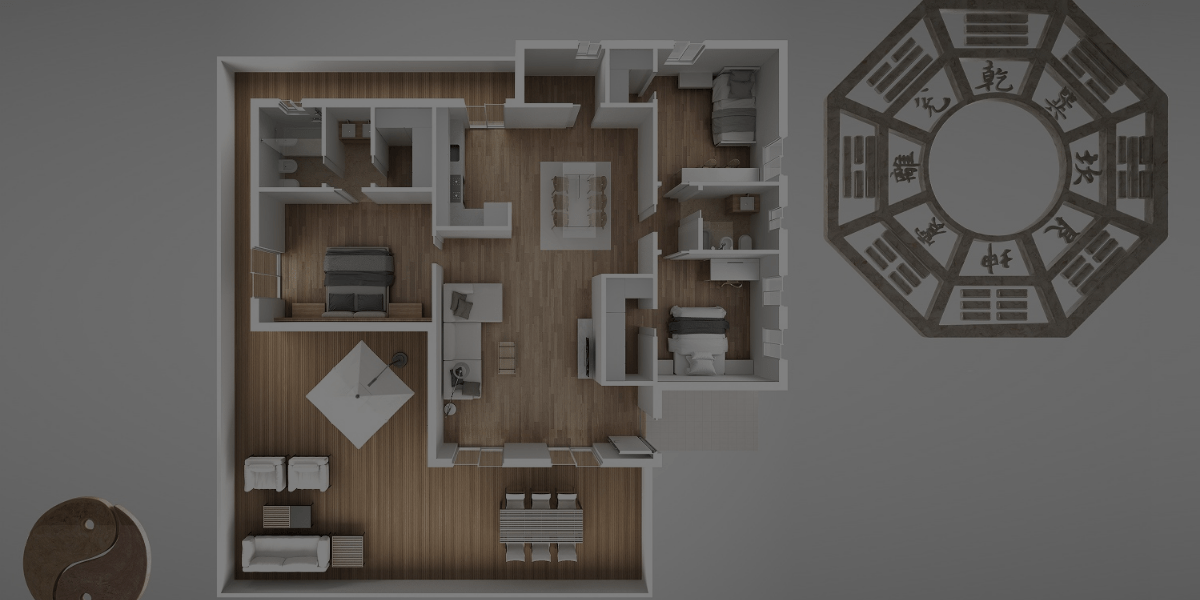In Part 1 of our two-part series, we introduced the Bagua Map, and examined why it’s a fundamental tool used in Feng Shui design. Today, we will continue this discussion by taking a look at:
- The 9 section of the modern Bagua Map!
- How to align the Bagua map with your client’s floor plan!
- The #1 secret to becoming a Feng Shui Bagua master!
So, let’s delve right back in!
As we mentioned in Part 1, the modern Bagua map is divided into 9 sections. Here’s an example of what it would look like:

The idea is that whenever you add any three numbers across the grid horizontally, vertically, or diagonally, the sum will always be 15. When you add any two numbers in the grid that are directly opposite each other, the sum will always be 10. These calculations are said to demonstrate the “magic” of the overall square.
The center of the Bagua Map represents personal health and well-being. This includes spiritual health, physical health, mental health, and emotional health. As a Feng Shui designer, always be mindful of which area of your client’s home falls into this center space.
While every room plays an equal part in the home’s overall flow of positive energy, the room that falls into the center space is especially critical. The design, color(s), decor, and overall pathways to and from the room all need to be optimized in a way that maximizes healthy energy flow.
Otherwise, any negative energy that grows in that space could have a direct affect on your client’s personal health!
The Guas
Each of the nine sections of the Bagua Map is called a “gua”. Each gua represents a different attribute of your client’s life. In addition to the gua dedicated to personal health, the other 8 guas are:
- Kan (pronounced “kawn”), which represents one’s career
- Gen (pronounced “gun”), which represents one’s knowledge and self-cultivation
- Zhen (pronounced “jun”), which represents one’s health and family
- Kun (pronounced “koo-en”), which represents love and marriage
- Dui (pronounced “dway”), which represents one’s creativity and children
- Qian (pronounced “chee-an”), which represents helpful people and travel
- Xun (pronounced “shu-en”), which represents wealth and prosperity
- Li (pronounced “lee”), which represents one’s fame and reputation

In addition, each gua has a variety of other important qualities associated to it. Specifically, each gua is associated to:
- A direction. North, South, East, West, etc. are all examples of directions a room would be facing. As your Feng Shui training will teach you, the direction a room is facing will have an impact on how it affects the client and the living space’s energy.
- An element. In Feng Shui, there are Five Elements you must come to know inside and out: Water, Metal, Earth, Wood, and Fire. Each gua in a Bagua map (and thus, each room in your client’s home) is associated with one of these Five Elements. By designing a room and its layout with respect to its respective element, you can help enhance better Ch’i flow of that particular gua.
- A number. Based on the Lo Shu grid, each gua is also associated with a number from 1-9. Guas falling on an even number will have more Yin energy, whereas guas on an odd number will have more Yang energy.
- An aspect of nature. Different guas will be associated with different parts of nature. By incorporating those respective nature elements into the room, its layout, its color(s), and its decor, you can help your client improve the overall energy flow in that given space, as well as in the overall home.
- A body part. In Feng Shui, it’s believed that the layout of the home is directly correlated with the body of the person living within its space. As such, each gua in the Bagua map is associated with a certain part of your client’s body. Failure to maximize positive Ch’i energy in a certain room can potentially lead to health concerns in its respective body part. For example, if the energy is off or bad within the Qian Gua (which is associated with the head), your client may become more prone to headaches.
- A person. Certain guas are associated with different relationships your client has with others, such as with friends, family, and romantic partners. Creating better Ch’i flow in those guas can lead to more fulfilling, positive relationships in their personal life!
- A color. Each gua is associated with a specific color, or colors. You can utilize them within their respective spaces to enhance energy flow throughout the home.

Aligning the Bagua Map with Your Client’s Floor Plan
As a designer, you already know that a floorplan is a scaled drawing of a room or building, shown from a bird’s eye view. A properly scaled floorplan will accurately show you the room (or home’s) measurements. As a designer, you’ll frequently work with individual room floorplans, floorplans for whole buildings or levels, and even floorplans for outdoor spaces.
As a designer specializing in Feng Shui, you can take your client’s floorplan a step further by using it in conjunction with the Bagua Map!
The more Feng Shui your client wishes to incorporate into her home, the more floorplans you’ll need to consider. For instance, if she wants you to help her with every room in her home, you’ll need a floor plan for every single level of the house. This process is called “layering” the Bagua Map.
In essence, you’ll align the floorplans with the Bagua map to determine what the current energy flow is in the home. From there, you’ll then be able to decide what needs to be done in order to improve and maximize better Ch’i flow, based on which rooms fall under which guas, which room is the center space, etc.
In order to do any of this, you’ll first need to understand how to properly align your client’s floorplan with the Bagua Map. So, how do you learn this?
The Secret to Becoming a Feng Shui Bagua Expert
The answer to this question is the exact same answer to the overlying question: ‘How can I become a Feng Shui Bagua master?’
By getting professionally trained, of course!

It takes a lot of research, time, and practice to truly understand the intricacies of Feng Shui design. Sure, you can self-teach through online reading, but how will you know if you’re absorbing the information correctly?
The best way to learn is to have an industry expert guiding you. So, enroll in a Feng Shui design course! Not only will you learn everything there is to know about the Bagua Map and Feng Shui design as a whole, your hard work will be rewarded with your very own professional certification.
Then you’ll not only know that you’re truly an expert – your clients will know it, too!
